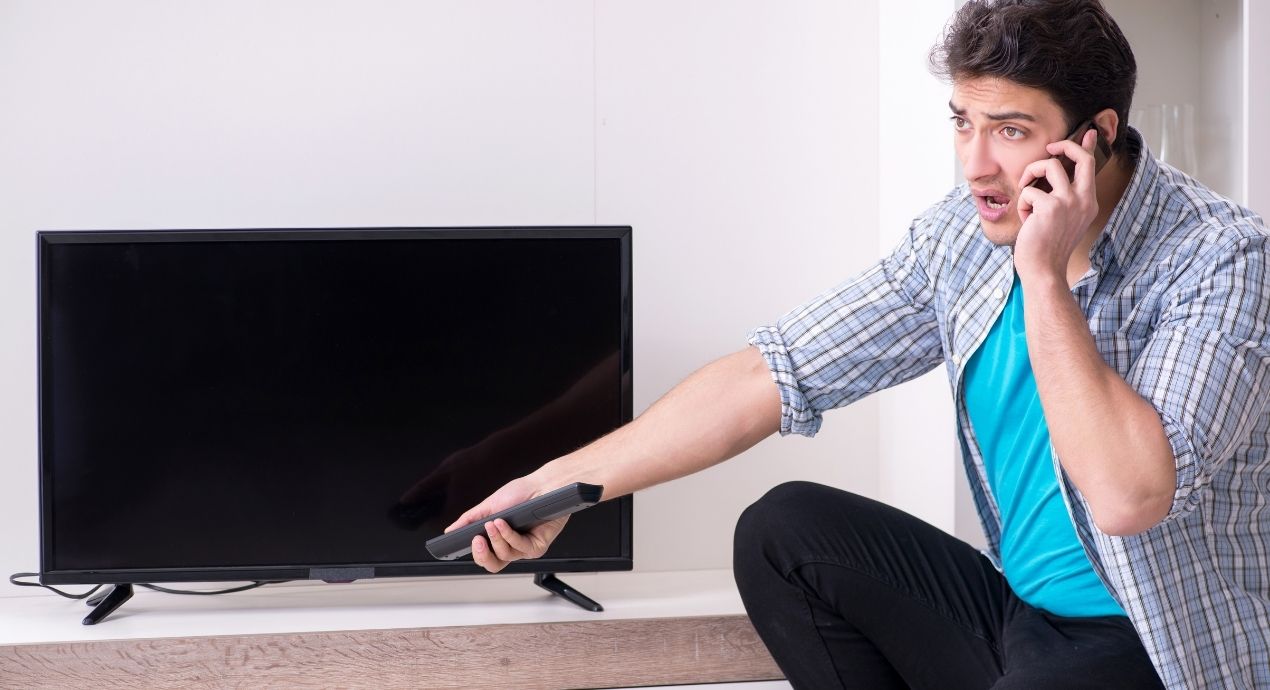
Contemplating coverage?
Subscribe to receive our emails & get
$200 off!
Have questions?
Call us: (833) 544-8273


Written By Erin Easley
With multiple inputs, devices, smart features, streaming platforms, and audio options, TV viewing can feel unnecessarily complicated. It’s common for viewers to struggle with a range of picture and audio problems, some of which may give the impression that there’s something wrong with the TV itself. But seemingly common TV repair problems can often be resolved with some quick TV troubleshooting.
In this article, we’ll review how to fix TV problems that most viewers are bound to encounter. If troubleshooting TV picture problems and audio issues with the following tips doesn’t help, it may be necessary to submit a claim on your manufacturer’s warranty or third-party TV warranty insurance.
If your TV screen is dark, check for LED indicator lights for signs of power. If there are no lights, sounds, or other signs of power, confirm that the power cord is securely plugged in and that the circuit does not need to be reset.
If your TV is powered on but is still without picture, cycle through the different sources or inputs. If the problem persists, check the power to your source device (i.e., cable box, PlayStation or Xbox, Apple TV, Roku, etc.). Ensure that your source device is securely connected to the TV with an appropriate cable, such as an HDMI.
If possible, it’s also worth trying another source device or another HDMI cable to confirm the problem is with the TV. You can try a different TV input as well. Sometimes the HDMI 1 input can fail, for example, but HDMI 2 will continue to work just fine.
If you’ve narrowed down the problem to the TV and are confident that your source devices and cables are functioning properly, you should contact your TV’s manufacturer, your warranty provider, or a repairperson.
Delayed audio makes for an irritating viewing experience. You may experience this problem whether you use the TV’s built-in speakers or an external speaker, such as a soundbar.
You’ll want to determine if the TV, source device, or broadcast source is the reason for your out of sync audio. If you’re noticing it on cable television, change the channel to see if the problem persists. If not, the channel with delayed audio will likely resolve itself.
If you notice out of sync audio regardless of your cable channel but other source devices are fine, adjust the audio delay in the settings on your cable box. If you notice the audio problem no matter what you play—cable, streaming devices, gaming consoles—then you’ll need to adjust the audio delay on the TV itself.
Pixelation is a common problem. Sometimes there’s nothing you can do about it because it’s a problem with the broadcast, not your TV. If you’re noticing frequent pixelation issues across multiple channels, check that all cable connections are tight and secure. You can also try powering off your cable box or other device, allowing it to rest for one minute, and then powering it back on.
If pixelation problems persist only on cable channels, contact your cable service provider. If they persist across different source devices, contact your TV manufacturer or warranty provider.
Use the same methods described above to troubleshoot poor picture quality. If dimness, discoloration, or distortion is present on only one channel, it will probably resolve itself in a short period of time. If you’re noticing it everywhere, you’ll need to play with the picture settings on your TV. If you think a setting was changed inadvertently, most TV models have a “restore default” option.
What people refer to as the “soap opera effect” is actually motion smoothing. Different TV models and manufacturers may use a slightly different term, such as “Auto Motion Plus” (Samsung) or TruMotion (LG). This strange effect occurs when your TV simulates a higher framerate when the source is displayed at a standard 24 or 30 frames per second.
You might enjoy this setting on some content, such as sports broadcasts. But most people find it distracting. Simply navigate your TV’s picture settings menu to toggle it off.
If you encounter a TV problem that requires actual repair, you may be able to have the manufacturer resolve the issue as long as the TV is still under warranty. If the warranty has expired, however, you’ll need to pay out of pocket.
You can avoid those out-of-pocket expenses with a home electronics warranty. Liberty Home Guard can provide expert repair services at or below wholesale rates, and you can bundle your extended warranty electronics coverage with coverage for other appliances and equipment around your home.
Use our website for a free quote or call (866)-225-7958.
Stay Ahead of Potential
Home Mishaps!
Subscribe to our Liberty Home Guard Newsletter and gain access to exclusive content that ensures your peace of mind.